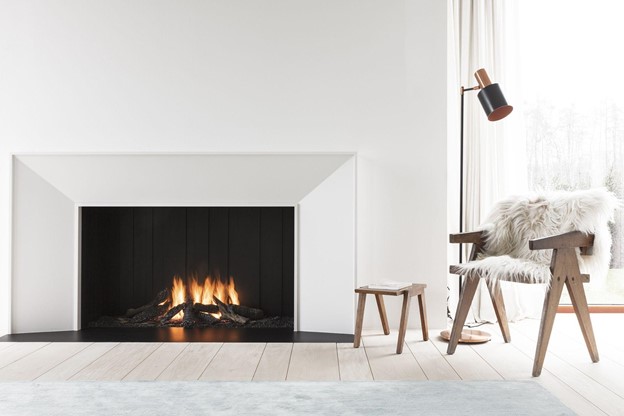There is a thriving community surrounding the renovation of older buildings. There are several regulations you might need to consider, but a restoration of an old Tudor fireplace or Victorian stone fireplace is utterly beautiful. In this article, we explore the history of fireplaces and how they have changed across the centuries in the UK.
The History of Fireplaces
Hearth equates to home, and a fireplace is essential to any home. A fireplace is often associated with cosiness, comfort, and warmth. Let’s look back at its simple beginnings and explore its evolution.
Stone Age
A fireplace in ancient times was located in an area where fires could quickly be started and controlled. This was when the Stone Age people discovered fire. Besides being a source of heat, they also used it for cooking.
The Celts
Around 500 BC, as a protective measure against the elements, Celts built huts with central firepits, with holes in the top to let smoke escape. There was room around the fire for dwellers to gather.
The Romans
Much like contemporary heaters, Roman hearths were portable and could be moved where needed. In contrast, permanent fixtures were not suitable for Romans’ lifestyles.
Mediaeval England
Following the fall of the Roman Empire, fireplaces returned to their original designs. English peasants used these fire pits to cook and keep warm.
1066
The fireplace was invented at this time. As two-story houses evolved, chimneys were designed to dispose of smoke properly. There were no fire pits in places anymore; instead, fireplaces were mounted on the outside wall. A chimney created a draft and expelled the smoke outside, allowing people to install fireplaces on different floors.
1600 to 1700s
It was not uncommon for separate rooms to have fireplaces, but walk-in fireplaces were often used in the kitchen and for gatherings. A fire was made at the centre of the room, and a chimney looked over it.
Prince Rupert of the Rhine invented the fireplace grate in 1678. As a result of elevating the firewood frame, he found that air circulated more effectively under it, fuelling and increasing the fire’s efficiency.
1742
Benjamin Franklin developed the Pennsylvania fireplace, the world’s first cast iron stove. It was designed to consume a quarter of the fuel and produced twice as much heat. Not only did this improve the safety of having a fire in the home, but it also increased the overall heating efficiency. A fireplace became a central feature of rooms during the same period, and people gathered around it in the evening.
1796
Most fireplaces today are based on the designs of Rumford fireplaces. Rumford’s 1796 fireplace featured a tall, shallow firebox and angular covings to increase heat output. It burned wood more efficiently and emitted fewer smoke thanks to its innovative design.
1800 to 1900s
There were two parts to a fireplace by the 1800s: an insert and a surround. Various materials were used, including granite, marble and cast iron. Additionally, decorative elements such as patterned tiles became increasingly popular during the Victorian era.
Gas fires and sustainable solutions are relatively new developments. In the early 1900s, flame effects and living flames became increasingly prevalent, and gas fires were manufactured to reduce smoke emissions. During this time, fireplaces have also shifted from a heat source to a decorative feature.
1968 saw the invention of the pivoting suspended fireplace, setting the stage for more innovative art deco designs.
1980 to 1990s
With the advent of more environmentally friendly and cost-effective fireplace options in the 1980s, more and more homeowners began to look for these options. Pellet appliances and wood-burning stoves grew in popularity as people sought more economical ways to generate heat.
1995
An electric fireplace was introduced in 1995. This reproduced the feel of an authentic wood-burning fireplace without releasing toxic greenhouse gases. By submitting these, homes that do not have chimneys could enjoy the allure of a fireplace.
The present day
Today, functionality and style are hands in hand with fireplaces, which are available in numerous styles, such as rustic, vintage and minimalist. Our array of choices is shaped by fireplace history. Innovations throughout the history of fireplaces have given rise to modern energy-efficient fireplace designs.
The Act of Fireplace Restoration
Period fireplaces and surrounds are highly valuable, so fireplace restoration is crucial. But whether they’re antique or contemporary, fireplaces require care. Fireplaces are more than just a source of heat. They are the heart of a room, the place where people share stories and make memories.
Water damage, cracks in the masonry and deterioration of the fireplace can all cause fireplace restoration to be necessary. Repairing minor problems is often simple, but more extensive damage requires more comprehensive inspections and restoration. In addition, fireplaces may require restoration if the dimensions of the firebox prevent proper ventilation.
A professional fireplace restoration can ensure peace of mind about your fireplace’s functionality, beauty and safety. It protects residents. Additionally, this guarantees that the fireplace is safe to use beyond just being functional and efficient.
How to Restore an Antique Stone Fireplace
If you want to get an idea of bringing your antique stone fireplaces back to their former glory, here’s how it typically happens.
Performing a thorough inspection
Rejuvenating an old fireplace usually involves several stages, from recreating the opening to lining the hearth and flue with the most reliable material. A thorough inspection is needed to determine how well the chimney functions or if it needs lining to work correctly.
Fireplace repair
Owners who inherit an existing fireplace they want to repair should have the chimney swept first. In this process, the flue is cleaned and inspected, allowing you to determine if it needs to be repaired. Whenever an unused chimney is covered over, it must be opened again.
Period fireplace repair
Various issues are commonly encountered with period fireplaces, such as excessive painting, damaged tiles and hearths, misaligned firebacks and missing or damaged metal parts. A competent DIYer can deal with issues like chemically stripping paint. It is also possible to clean, restore and seal stonework on-site. Meanwhile, you can purchase brand-new tiles online or visit a granite or marble shop in your area.
Professionals should repair metal components if they are damaged or missing. And in case of a severely damaged fireplace, it may be advisable to start over using a replica or reclaimed fireplace.
Meeting regulations
Compliance with the regulations if structural alterations are being made. When decommissioning an old gas or electric fireplace, you should leave it up to the professionals.
Bespoke Fireplaces: The Perfect Addition to Your Home
Whatever your fireplace needs, from replacing an outdated London fireplace or adding a stylish one to your home, Bespoke Fireplace Designs is here to help. Contact our team now, and we’ll be glad to assist you with any fireplace-related enquiries you may have.



